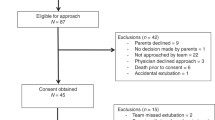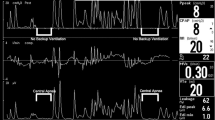Abstract.
Objective: The aim of the study was to assess the influence of nasal continuous positive airway pressure (NCPAP) on breathing pattern in preterm newborns. Design: Prospective study. Setting: Neonatal intensive care unit. Patients: Ten premature newborn infants on NCPAP (gestational age range from 27 to 32 weeks, mean birth weight 1300±460 g) admitted in our neonatal intensive care unit (NICU) for respiratory distress syndrome. Methods: Breathing patterns and changes in lung volumes level were obtained using respiratory inductive plethysmography (RIP), at random CPAP levels (0, 2, 4, 6 and 8 cmH20). Raw data were analysed for end-expiratory lung volume level (EELV-level), tidal volume (Vt), respiratory rate, phase angle and labour breathing index (LBI). Results: CPAP increased EELV-level by 2.1±0.3×Vt from 0 to 8 cmH20 (p<0.01). Vt increased by 43% from CPAP of 0 cmH20 to CPAP of 8 cmH20 (p<0.01). We also found that CPAP lowered the phase angle (from 76±21° at CPAP of 0 cmH20 to 30±15° at CPAP of 8 cmH20; p<0.01 ) and LBI (from 1.7±0.8 at CPAP of 0 cmH20 to 1.2±0.3 at CPAP of 8 cmH20; p<0.05). Conclusion: NCPAP improves the breathing strategy of premature infants with respiratory failure, as reflected by improved thoraco-abdominal synchrony, increased Vt and reduction of the LBI. This effect is associated with an increase in EELV-level with CPAP level. However, further investigations are necessary to establish the best CPAP level that ensures both safety and efficiency.
Similar content being viewed by others
Author information
Authors and Affiliations
Additional information
Final revision received: 1 June 2001
Electronic Publication
Rights and permissions
About this article
Cite this article
Elgellab, A., Riou, Y., Abbazine, A. et al. Effects of nasal continuous positive airway pressure (NCPAP) on breathing pattern in spontaneously breathing premature newborn infants. Intensive Care Med 27, 1782–1787 (2001). https://doi.org/10.1007/s00134-001-1117-1
Received:
Accepted:
Published:
Issue Date:
DOI: https://doi.org/10.1007/s00134-001-1117-1




